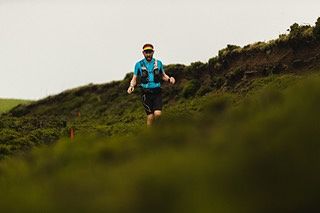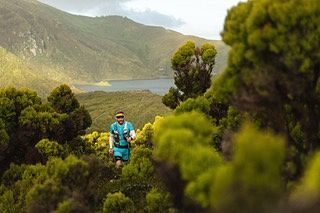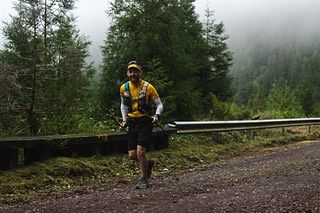Ultrarunner Tom Crossland is gearing up to run 1,900 miles – the equivalent of a touch under 73 marathons - around the coast of England and Wales to raise funds for TRIBE Freedom Foundation.
Tom’s upcoming feat of physical endurance to help raise awareness of human trafficking and modern slavery is all the more impressive as he suffers from a form of Cerebral Palsy called hemiplegia, which affects the left side of his body.
Rather than seeing his condition as a disability, Tom tells us how his meticulous approach to preparation and training helps him to "Just Keep Running"…
Hi Tom, before we delve into your Run To Refuge project, can you tell us how CP affects you physically?
As a kid I fell over all the time. I had a permanent hole in the left knee of my trousers and a graze on my left hip. This never stopped me from being active and taught me that success isn't measured by how many times you fall over but by how many times you get up.
Over the years I’ve had to learn to cope with the differences between my left and right side. For example, the balance on my left side is poor and it’s harder for me to keep my left side relaxed, so it takes a lot more energy to do everyday tasks. This means my resting metabolism is higher and so I need to eat more food, more frequently.

That said, I’m lucky that the brain damage that caused the CP was minimal and I think my condition has driven me to ‘go longer’ in endurance sport. I know I’m unlikely to ever be fast enough to compete at the front of a race, but I can train hard and prepare meticulously so that I’m able to go further.
That’s a great outlook. How have you developed that endurance mentality and your ability to go further in races over the years?
I was very lucky to have the parents I did. They didn’t see CP as a disability and even though I was constantly falling over, they pushed me to be outside. My dad was a good club runner and so I would often participate in the fun runs at the same time as he was running a race.
When I got to secondary school, there was much more emphasis on representing the school in teams than there was in participation for fun. That wasn’t going to be for me - I was usually picked last in team sports.
It wasn’t until I went to university that I encountered opportunities to try sports that weren’t offered at school. My partner was a horse rider and so I joined the university's riding club, as well as the rowing club.
I had to work hard on my coordination to ride which had the added benefit of helping with the balance required to row. Rowing was my first introduction to daily structured training and I loved it. I discovered that the more I trained, the less of a problem my CP became.
After uni, I tried ultra-running and rediscovered my love of running from my childhood.

Since completing your first ultra in 2015, you’ve finished the 235-mile Deadwater Ultra in six days and the Grand To Grand multi-day race in Utah. So, what inspired you to take on 1,900 miles for the Run To Refuge project?
This challenge was born out of a desire to test the limits of my physical and mental ability.
I was aware of the ongoing conflict in Syria that was causing a large number of people to leave their homes to seek asylum in other countries. I thought it would be a really good project to run from Greece to the UK, to mirror the route that many refugees were making to seek asylum. I had planned to make this 2,200-mile journey in the summer of 2020, until the pandemic arrived and changed my plans.
I’m now running 1,900 miles around the English and Welsh coast in aid of the TRIBE Freedom Foundation, who increase awareness of human trafficking and modern slavery.
There are an estimated 40.3 million modern slaves worldwide, including 136,000 in the UK, and I wanted to do something to help. TRIBE was founded after three friends ran 1,000 miles across Eastern Europe to raise funds to set up the UK’s first home for trafficked children and this fitted well with my experience of using endurance sport for good.
That's a very worthy cause. So what has a typical week of training looked like as you prepare for this endurance challenge?
I train on a four-week cycle with a recovery week as the last week of that cycle. The other three weeks I train between 11 and 20 hours a week.
This has recently included a lot of additional walking to get time on my feet without the risk of running injuries, although in March I completed two weekends of two 50k runs.
| Day | Session |
|---|---|
| Monday (rest day) | 30 min spin on the turbo (55% FTP) |
| Tuesday | 60 min easy pace run |
| 65 min fast walk | |
| Wednesday | 60 min interval session on the turbo (90% FTP) |
| 65 min fast walk | |
| 15 min yoga | |
| Thursday | 45 min hilly, steady run |
| 65 min fast walk | |
| Friday | 60 min endurance spin on the turbo (65/75% FTP) |
| Saturday | 60 - 90 min hilly, steady run (using 9 min run - 1 min walk strategy) |
| 2 - 3 hours walking | |
| Sunday | 3 - 5 hours long run (9 min run - 1 min walk) |
And every day will involve 10-20 minutes of stretching and S+C.
There'll be a support van with you during the project, but you’ll be self-sufficient for large sections of the run. Have you had a chance to develop your hydration and nutrition strategy?
I’ll use a ‘9-minute run / 1-minute walk’ strategy as recommended by my coach Rob Wilby from Oxygen Addict Triathlon. During every walk break I’ll take a small sip of drink and aim to consume about 500-700ml an hour depending on the temperature.
I use PH 1500 for preloading before and for recovery after long runs.
I usually carry about 1 litre of fluid depending on how far it is to the next tap or shop, and my water bottles will have PH 1000 in them.
I haven’t really altered the nutrition strategy that I’ve developed over the years. I eat about 100 - 200 calories every 45 minutes. During the recent back-to-back 50k runs I’ve been completing, I’ve tried to eat something more substantial about halfway through.

Taking into account what you’ve learned from past ultras and your own preparations for the Run To Refuge, what would be your best advice to fellow athletes who are preparing kit for multi-day events?
Use the internet to research but try not to fall into the trap of ‘analysis paralysis’.
Make sure you test all your kit - especially shoes and pack - before you set off. Ideally you should test it over multiple days to make sure it meets your needs.
Spend a long weekend testing your nutrition to see if you have enough. Also consider whether you really want to be eating porridge seven days in a row…

If you can’t stomach your food, it can change the race from being enjoyable to outright survival. Whilst you must consider the weight of your food, there’s little point carrying the lightest options if you won’t want to eat them. I remove the freeze-dried food from its heavy foil bags for a six-day event - the bags weighed about 500g!
As well as being a physical challenge, there will be a huge mental element to the Run To Refuge. Do you have any strategies that you’ll use to help you get through the long miles and days?
When things get tough, I try and think about the positives such as what a privilege it is to be outside doing what I (supposedly!) love.
I’m always breaking the run down into smaller chunks, focusing on getting to the next walk break.
And ever since watching Finding Nemo, I have the constant mantra in my head: ‘Just Keep Running’ - imagining Dory swimming along makes me smile and can lift my mood.
Thanks Tom and good luck! The PH team are looking forward to joining you for the South Coast section of the Run To Refuge.
Visit RunToRefuge.com to support Tom’s challenge by donating what you can, registering to join Tom as a runner or crew member, and you can also sign up to take part in the Run To Refuge Virtual Challenge.